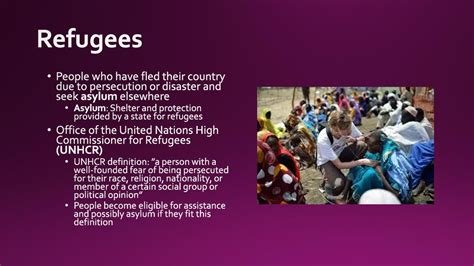What is a Refugee?

According to the United Nations High Commissioner for Refugees (UNHCR), a refugee is someone who:
- Has been forced to flee their country because of persecution, war, violence, or a natural disaster
- Is outside their country of origin
- Is unable or unwilling to return to their home country due to a well-founded fear of persecution
Key Characteristics of Refugees
- They are forced to flee. Refugees are not simply people who choose to leave their homes. They are forced to flee due to circumstances beyond their control.
- They are outside their country of origin. Refugees have crossed an international border to seek safety.
- They are unable or unwilling to return. Refugees cannot or will not return to their home country due to a well-founded fear of persecution.
Types of Refugees
There are many different types of refugees, including:
- Political refugees are people who have been forced to flee their country because of their political beliefs or activities.
- Religious refugees are people who have been forced to flee their country because of their religious beliefs or practices.
- Ethnic refugees are people who have been forced to flee their country because of their ethnicity or national origin.
- Environmental refugees are people who have been forced to flee their country because of environmental disasters, such as climate change or natural disasters.
Causes of Refugee Flows
There are many different factors that can cause refugee flows, including:
- War and conflict is the leading cause of refugee flows. When war or conflict breaks out, people are often forced to flee their homes to escape violence and persecution.
- Political oppression is another major cause of refugee flows. When governments oppress their citizens, people may be forced to flee to escape persecution or imprisonment.
- Religious persecution is also a major cause of refugee flows. When people are persecuted for their religious beliefs or practices, they may be forced to flee to escape violence or discrimination.
- Economic hardship can also lead to refugee flows. When people are unable to meet their basic needs in their home country, they may be forced to flee to find better opportunities.
Consequences of Refugee Flows
Refugee flows can have a significant impact on both the refugees themselves and the countries that receive them.
For refugees, refugee flows can lead to:
- Loss of home and community
- Trauma and mental health problems
- Economic hardship
- Discrimination and xenophobia
For receiving countries, refugee flows can lead to:
- Increased demand for resources
- Social tensions
- Political instability
Addressing the Refugee Crisis
There is no easy solution to the refugee crisis. However, there are a number of things that can be done to address the problem, including:
- Providing humanitarian assistance to refugees, such as food, water, shelter, and medical care.
- Resettlement of refugees to other countries, where they can rebuild their lives in safety and dignity.
- Addressing the root causes of refugee flows, such as war, conflict, and persecution.
- Challenging discrimination and xenophobia against refugees.
Conclusion
The refugee crisis is a complex and global problem. There is no easy solution, but there are a number of things that can be done to address the problem. By working together, we can help refugees rebuild their lives in safety and dignity.
Refugee Flows: Data and Statistics
- According to the UNHCR, there are over 26 million refugees worldwide.
- The majority of refugees (85%) live in developing countries.
- The top five countries of origin for refugees are: Syria, Afghanistan, South Sudan, Myanmar, and Somalia.
- The top five countries of asylum for refugees are: Turkey, Pakistan, Uganda, Lebanon, and Germany.
- In 2021, over 1 million people were newly displaced due to conflict and persecution.
Refugees and Human Rights
Refugees have the same human rights as everyone else. These rights include the right to:
- Life
- Liberty
- Security
- Freedom of movement
- Freedom of expression
- Freedom of religion
- Education
- Healthcare
- Work
Challenges Facing Refugees
Refugees face a number of challenges, including:
- Discrimination and xenophobia
- Lack of access to basic services
- Trauma and mental health problems
- Economic hardship
- Language barriers
- Legal challenges
Tips for Helping Refugees
There are many ways to help refugees, including:
- Donate to refugee organizations.
- Volunteer your time to help refugees.
- Raise awareness about the refugee crisis.
- Challenge discrimination and xenophobia against refugees.
- Support policies that help refugees.
Conclusion
The refugee crisis is a complex and global problem. There is no easy solution, but there are a number of things that can be done to address the problem. By working together, we can help refugees rebuild their lives in safety and dignity.
